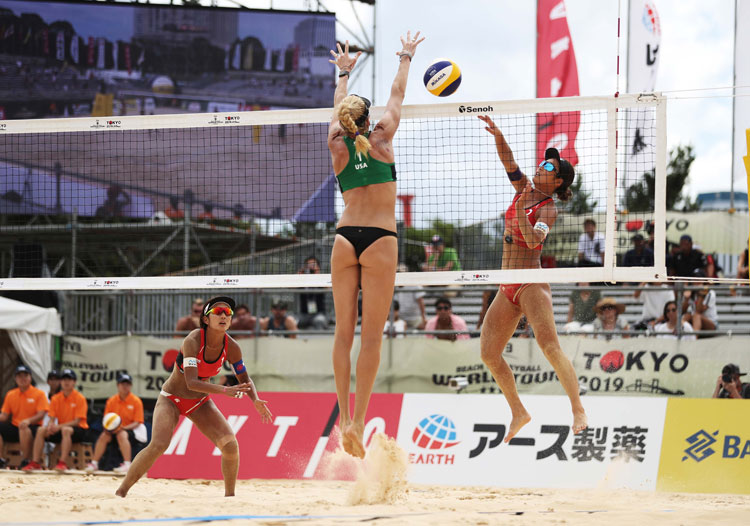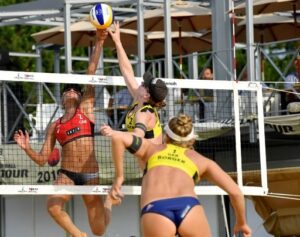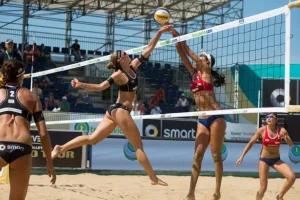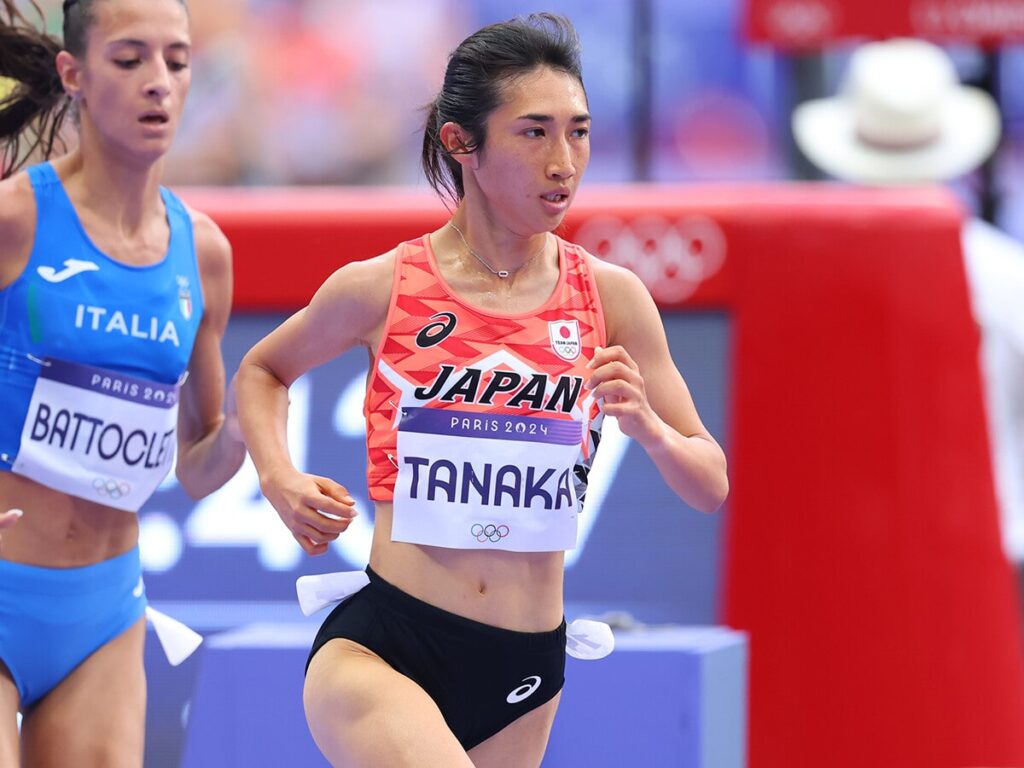
Blocking in beach volleyball is an important skill to effectively stop your opponent’s attacks and create opportunities to score points.
This technique is recognized for its importance at all levels, from beginners to professional athletes.
But successful blocking requires more skill and strategy than just jumping high. It requires precise timing, proper hand position, and insight into the other person’s intentions.
In this article, we will unravel the knowledge and techniques for mastering blocks in beach volleyball, from the basics to advanced strategies.
We’ll also delve into how to deal with common challenges players encounter, as well as takeaways from the blocking strategies of top players.
Use this article as a guide to improve your beach volleyball blocking skills and take your game to the next level.
目次
Basics of blocks in beach volleyball
In beach volleyball, blocking is an important technique that has the power to change the flow of the game.
We will delve into the basics of the role of blocking, which directly prevents the opponent’s attack and creates scoring opportunities, and its tactical importance.
Block role
The main role of blocking in beach volleyball is to block the opponent’s spike attack directly on the net, thereby creating an opportunity to score points or reducing the effectiveness of the opponent’s attack.
A successful block puts pressure on the opposing team and also has the effect of increasing the morale of your own team.
Importance of blocks
- Creating Scoring Opportunities: Direct blocks not only allow you to score points, but successful blocks also hinder the opposing team’s attack and create counter-attack opportunities for your team.
- Limiting your opponent’s tactics: Effective blocking limits your opponent’s means of attack. By limiting attacking options, it becomes easier for defenders to predict their opponent’s attack patterns.
- Psychological Advantage: Blocks can put a lot of pressure on the opposing team. By successfully making blocks in a row, you can shake the confidence of your opponent and make them less accurate.
Basics of block technology
- Timing: The timing of your jump is important for effective blocking. Jump at the perfect moment to match your opponent’s launch timing and swing.
- Positioning: Proper positioning relative to the net is important. When blocking, you need to position your body properly against the opponent’s attacking line and cover as much space as possible.
- Use of hands: When blocking, it is important to spread your hands wide to block the path of the ball. Adjust your hand shape and angle to effectively block your opponent’s spikes.
Blocking in beach volleyball is a complex skill that requires not only technical mastery but also strategic thinking.
Mastering basic techniques is the first step to improving your beach volleyball game.
By gaining experience in actual battles, you will be able to acquire more advanced blocking techniques and tactics.

Basic steps of block technology

advanced blocking strategy
In beach volleyball, advanced blocking strategies greatly influence the flow of the match and are the key to victory.
By identifying the opponent’s attack patterns and setting up effective blocks, it is possible to give the opposing team an overwhelming advantage.
Here, we delve into advanced blocking strategies.
Read your opponent’s attack patterns
- Player tendency analysis: Analyzes past match footage of opposing players to understand their preferred patterns and weaknesses when attacking. For example, identify players who tend to spike from certain approaches or prefer cross attacks.
- Observe during the match: As the match progresses, carefully observe whether there are any changes in your opponent’s attack patterns. Tactics may change from set to set, so flexibility is required.
Effective block setup
- Block position: Fine-tune your block position based on your opponent’s attack tendencies. For example, if your opponent prefers powerful straight attacks, set the block position slightly inside to respond effectively.
- Utilize Feint Blocks: Instead of actually attempting to block every attack, sometimes use feints to disrupt your opponent’s attack pattern. This increases the opponent’s uncertainty and reduces the accuracy of the attack.
Combination with team strategy
- Coordination with the defense: Blockers must work closely with the defense. Clarify the division of roles in advance so that defensive players are responsible for areas that cannot be covered by blocks.
- Enhanced communication: Blocking strategies are based on close communication with teammates. We will work closely together through pre-game strategy meetings and during-game signals.
Mastering advanced blocking strategies is one of the important challenges for advanced beach volleyball players.
By accurately reading your opponent’s attack patterns and developing appropriate blocking strategies depending on the situation, you can establish an advantage in the match.
Constantly analyzing the opposing team and honing your own blocking techniques and strategies will be the path to growth as an advanced player.

Block training and practice methods
Professional training and practice are required to improve your blocking technique in beach volleyball.
Here, we will introduce some practical practice methods to improve your blocking technique.
Jumping power improvement training
In order to maximize the effectiveness of blocks, the ability to jump high is essential.
Squats, plyometrics (jumping training), calf raises, etc. are effective training methods for increasing jumping power.
These exercises will help you develop lower body strength and create explosive power.
block form practice
Learning correct block form is the basis for improving your technique. Practice your form using the steps below.
- Check your standing position in front of the net: Stand facing the net with your feet shoulder-width apart.
- Jump practice: Practice jumping movements when performing blocks. Jump while raising both arms and reach your hands to cross the net at the highest point.
- Practice hand position and shape: When jumping, your hands should go over the net and your fingers should be spread out to block the path of the ball.
Practical drill
We aim to improve your blocking technique by practicing in situations similar to the actual game.
When practicing with a partner, one person will be the attacker (spiker) and the other will be the defender (blocker), and the practice will take place in a real-life format.
The attacker hits the spikes at various angles and speeds, and the defender attempts to block them.
Through this drill, you will learn when to block and how to use your hands in realistic game situations.
video analysis
Videotaping and analyzing your block form and timing is also very effective for improving your technique.
In particular, you can pinpoint areas for improvement, such as jump height, hand position, and timing.
It is important to continue training and practicing these techniques to improve your blocking technique.
Also, by applying the sensations and techniques gained during practice to the actual game, you will be able to create more effective blocks.

Block analysis of top players
Top players who are successful in beach volleyball are not just physically capable, but also use advanced techniques and strategies.
Especially when it comes to blocks, you can learn many secrets to success from their technical analysis.
Positioning when blocking
When analyzing the blocking techniques of top players, the first thing to pay attention to is their positioning.
How do they read the movements of opposing spikers and place themselves in the optimal position?
They often predict the direction of the ball from the direction of their opponent’s shoulders, the timing of their jumps, and the pattern of their arm swings.
jumps and timing
The high block success rate of top players is also reflected in the accuracy of their jump timing.
They jump to reach the highest point at the moment the ball is hit.
Acquiring this timing accuracy requires countless hours of practice and real-world experience.
hand techniques
How to use your hands when blocking is also an important point when analyzing top players.
How does the hand go over the net and how does it change the path of the ball?
Many top players apply pressure by extending their hands into the potential trajectory of the ball and even blocking the opponent’s view.
Analysis of actual match footage
In order to understand these techniques more deeply, it is very effective to analyze actual game footage.
Observe a specific player’s blocking scene repeatedly and pay attention to the details of their movements.
It is also important to pay attention to factors other than blocks, such as the match situation, distance to the opponent, and positioning on the court, and understand the overall tactical implications.
Learning the blocking techniques of top players will directly improve your own play.
Learn these advanced techniques through continuous practice and practice while referring to content analyzed by beach volleyball coaches and commentators.

Frequently asked questions and answers (FAQ)
We have put together a list of common questions asked by beginners to intermediate players regarding blocks in beach volleyball, along with practical advice and solutions.
Q1: What is the basic position of the block?
A1: The basic position for blocking is to stand facing the net with your feet shoulder-width apart. When jumping, bend your knees firmly, raise your arms, and then reach over the net. The aim is to cover as much space as possible and prevent your opponent’s attacks.
Q2: How to improve block timing?
A2: To improve your timing, it is effective to practice paying attention to your opponent’s movements and predicting the moment when you will hit. It is important to read the timing of the spike from the opponent’s approach, the timing of the jump, and the movement of the hitter. This predictive ability is honed through repeated observation and practice.
Q3: What body parts are important for effective blocking?
A3: The most important thing in blocking is the position of the hands and arms. The hand should go over the net, spreading his fingers to create a large area for blocking the opponent’s attack course. It is also important to have lower body strength, which allows you to firmly transmit the power of your legs from the ground and support powerful jumps.
Q4: What is an effective drill for block practice?
A4: Effective block practice drills include practical exercises performed in pairs. One player will be the attacker and the other will be the blocker, and they will repeatedly practice blocking attacks from various angles and speeds. This allows you to physically learn the timing of blocks and how to use your hands in situations similar to a real match.
Q5: What should I be careful about when using my body when blocking?
A5: When blocking, it is important to position your body firmly toward the net, and when jumping, swing your arms wide and then reach toward the ball. Also, remember to use your knees softly when landing to absorb the impact and reduce the risk of injury.
These FAQs are a great starting point for learning beach volleyball blocking techniques.
By keeping these points in mind during actual play, you will be able to acquire higher-level blocking techniques.

summary
We provided a wide range of knowledge regarding beach volleyball blocking techniques, from basic positioning to advanced strategies and practical practice methods.
Blocking is one of the key techniques for success in beach volleyball, and the timing of your jumps, hand position, and the ability to read your opponent’s attack patterns are important.
Achieving effective blocks requires reviewing your technique through practicing proper form, hands-on drills, and video analysis.
You can also learn the secret to success by analyzing the blocking techniques of top players.
From their play, you can see that small differences in technique, such as positioning, jump height, and use of hands, have a big impact on a team’s victory or defeat.
By answering frequently asked questions about blocks in beach volleyball, we’ve also provided solutions to common problems faced by beginners and intermediate players.
We hope that through this guide you will gain a deeper understanding of beach volleyball blocking techniques, which will lead to improved performance in actual play.
Improve your blocking skills and aim for success in beach volleyball through continuous practice and competitive experience.
![When did baseball helmets start to have face guards? [Detailed explanation]](https://planotatico.com/wp-content/uploads/2024/06/herummettofacegard-min.jpg)




